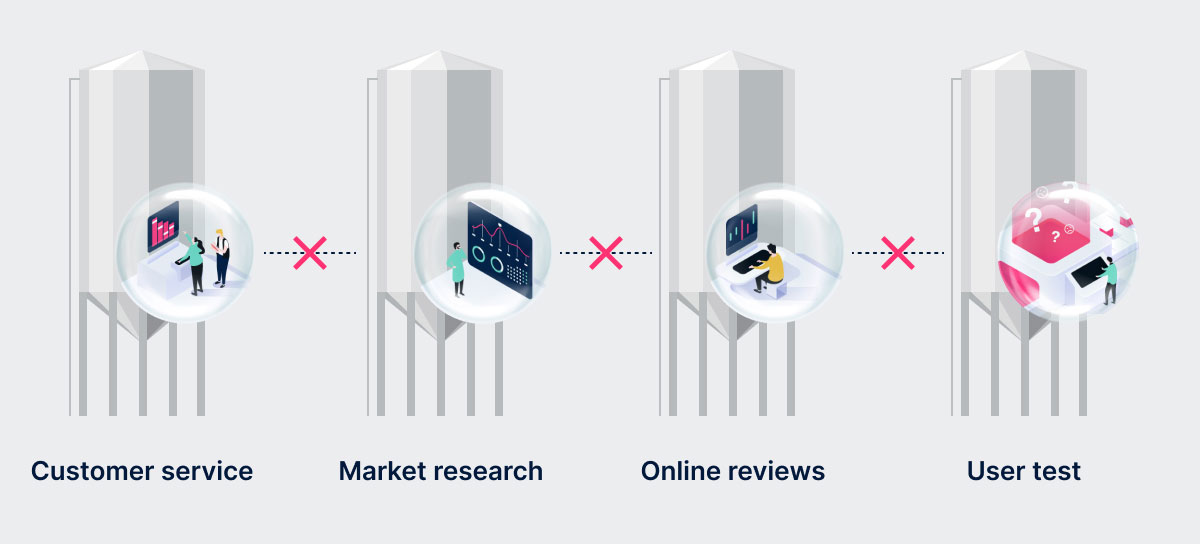
Why Your Company’s Internal Communication Should Be More Than Just Words
Spreading customer-centricity and communicating about customer experience inside your organization should be a priority rather than an afterthought. Learn how to identify the signs of communication breakdown before it’s too late and cultivate a culture of effective and open intercommunication in your company.
What is Internal Communication Breakdown in CX?
In the CX space, we frequently discuss the action gap problem. This is the inability to bridge the gap between customer feedback, insights, and taking action to improve products, processes, and retention. One of the main contributors to the action gap is the numerous communication holes that appear inside organizations, causing breakdowns in communication flows – rendering your company’s CX efforts ineffective.
A recent CX action management survey revealed that 50% of companies say they fail at communicating customer information and insights across the organization.
This article examines the whys of CX communication breakdown, the consequences of not adopting a water-tight internal communication strategy for your CX activities, and some handy do’s and don’ts to help foster more productive internal conversations.
1: Your company isn’t sharing customer insights internally
“One out of two CX professionals say their biggest obstacle by far is their company’s inability to propagate customer insights across the organization” – CX Action Management Study, 2022
Let’s begin with an obvious issue. Businesses spend significant resources gathering customer feedback to gain valuable insights about their customers. This is simply a wasted effort if the insights gathered are not communicated effectively within the company.
✔ Do’s:
- Use internal communication tools (e.g., dedicated slack channels).
- Hold regular all-hands meetings to share customer insights.
- Share more pertinent information with relevant stakeholders on appropriate channels.
✘ Dont’s:
- Don’t keep the information to yourself (see below) or within your inner circle.
- Don’t info-dump everything into one mass company email that people may not understand, or even read.
2: Your company works in silos and with siloed data

“42% of customer data and information is siloed, which leads to no follow-up on customer feedback campaigns.” – CX Action Management Study, 2022
Organizational silos are problematic in general and worth eliminating for many reasons, especially regarding CX. Silos don’t just hinder communication; silos can also skew how customers are perceived and understood.
✔ Do’s:
- Centralize information in one single place for easy access.
- Use silo-free platforms to enable seamless information exchange and workflows.
- Involve more colleagues across different functions.
✘ Dont’s:
- Don’t work in silos 🙂
- Again, don’t rely on email as your sole communication channel, as it can cause information silos.
3: Your company doesn’t connect CX to internal processes
“70% of CX professionals say there is a strong link between innovation and
customer feedback. Only 25% of companies say they have mastered the challenge of translating insights into innovation.” – CX Action Management Study 2022
So your business has collected valuable customer feedback, yet you’ve not established an internal process and communication strategy to get the right information to the right stakeholders so that the right decisions can be made towards innovation.
✔ Do’s:
- Map your internal stakeholder journey (people, processes, objectives) with a tool like Miro.
- To compare employee and customer expectations, combine your stakeholder journey map with your customer journey map.
- Engage with stakeholders regularly.
✘ Dont’s:
- Don’t assume departments are always aligned.
- Don’t create a process that isn’t constantly changing and evolving.
4: Your company has internal resistance towards CX
“50% of large businesses face internal resistance with their CX initiatives.” – CX Action Management Study, 2022
The larger the company, the more resistance to change and the high probability of stakeholders becoming bottlenecks. For instance, a lack of commitment from those authorizing projects or too many stakeholders involved in decision-making processes – leading to lower agility and speed. Without buy-in from your internal stakeholders, especially C-suite, your customer experience efforts will fall short.
✔ Do’s:
- Communicate and engage with stakeholders – translate CX success into business value.
- Resistance is a type of feedback – understand why people resist change and address it.
- Adopt leaner decision-making processes and promote autonomy to increase speed.
✘ Dont’s:
- Don’t ignore resistance – disengaged colleagues will slow down your CX endeavors.
- Don’t expect to overcome resistance overnight – it’s an ongoing process.
5: Your company uses one-way communication flows
“The internal Customer Experience determines the external Customer Experience.”
– Shep Hyken, Customer Service and Experience Expert
The problem with internal one-way communication flows is they only tell half the story. You wouldn’t communicate with customers and not listen to what they have to say. There can be a false sense of security when management teams share top-down messages, assuming their points are heard, understood, and agreed upon. Conversely, dissatisfied colleagues may feel they have no real channels to offer a response.
✔ Do’s:
- Create a feedback channel to all points of internal communication.
- Make sure your message is clear, to the point, and easy to understand.
✘ Dont’s:
- Don’t overload your messages with jargon and buzzwords – not everyone speaks the same language.
- Don’t communicate too many ideas and thoughts at once – so focus on one thing.
6: Your company uses the wrong communication channels

“92% of managers and 90% of employees agree that digital-communication tools help everyone get on the same page.” – 2021 Internal Comms Connect Survey
As we’ve repeatedly stated, sending out email blasts to employees is not an effective way of communicating. IORG says that twenty-eight percent of the workday is eaten up by information overload, and a study of 56 million internal emails found that only 37 percent of employees read them in full.
✔ Do’s:
- Communication is more than just words – create organizational experiences that excites, engages and inspires colleagues.
- Tailor your multichannel communication.
- Marketing teams may digest information better using dashboards or Slack, Sales may prefer face-to-face, etc.
- Constantly evaluate the channels you are using.
✘ Dont’s:
- Don’t just use emails or single channels.
- Don’t splash out an expensive IC tool, unless you are convinced your employees will use it to it’s fullest potential.
7: Your company doesn’t repeat key messages enough
“Delivering your message in different ways, over time, not only increases retention and impact, but it gives you the chance to describe what you’re doing from several angles.” – Seth Godin
Repetition is the key to information retention. The more people see or hear something, the more they remember it. For internal communication, repetition can also be used to enhance messages, by adding more information to the story so that the added details also become accepted knowledge.
✔ Do’s:
- Spice-up and tweak your messages over time, to lower boredom and increase engagement.
- Repeat messages on all communication channels.
- Repetition of words and ideas is incredibly effective. Think Martin Luther King’s “ I Have a Dream” speech, or when Neil Armstrong declared, “One small step for man, one giant leap for mankind.”
✘ Dont’s:
- Don’t expect results immediately. It can take several times for information to sink in and several weeks for a new behavior to become automatic.
8: People in your company rely on assumptions
“It is dangerous to assume, because you might make an “ass” out of “u” and “me.” – Felix Unger (Tony Randall) from Neil Simon’s The Odd Couple (CBS, 1970)
Assumptions derail communication. Look behind every miscommunication, misunderstanding, misjudgment, or mistake – and you’ll find that someone made an assumption. An assumption is merely an unexamined belief.
✔ Do’s:
- Be open to questions, and ask questions. Tag Q&As at the end of communication sessions.
- With stories, always start at the beginning. Not everyone may be up to your speed.
- If someone expresses a follow-up item, paraphrase it back to them, even if you think you’ve understood.
✘ Dont’s:
- Don’t expect others to feel the same way as you.
- Don’t over-rely on experience alone or arrive at a problem with preconceived ideas.
9: Your company communicates too much industry jargon
“To convey authenticity, communicators should avoid and reject words and phrases that don’t match their natural speaking style.” – Joel Schwartzberg, Author of The Language of Leadership
The curse of knowledge, or the curse of expertise, is a mental bias that occurs when an individual communicates with others assuming they have the knowledge or experience to understand. This type of unnecessary communication is usually filled with jargon and technical speak that those trying to consume the information don’t always understand.
✔ Do’s:
- Run your communication by a comms expert in your company, someone who knows how to speak to a wider audience in broad strokes.
- Whenever using terminology, explain and explain again. Publish a glossary of terms.
- Normalize people asking questions in real time. Remember, not everyone speaks the same language.
✘ Dont’s:
- Don’t rely on jargon and buzzwords – they can scream inauthenticity, or “empty suit.”
- Don’t use acronyms or shorthand without mentioning the phrase behind the abbreviation. e.g., “CTR (Click Through Rate)” or “CLV (Customer Lifetime Value)”.
10: Lack of commitment towards customer-centricity from the top
“Ask CEOs or senior management, when was the last time you served a customer that had a problem?” – CX Author Adrian Swinscoe, speaking about embracing customer-centricity in the workplace.
You hear CEOs and business leaders championing CX and “putting customers at the center of everything they do,” but are they genuinely practicing what they preach? The sincere ones are committed to a sustained CX cadence, and the insincere or unconvinced lose interest in customer-centric activities in a few months. 50% of large companies list ‘lack of management buy-in’ as one of their top 3 CX problems, with more than half saying it’s the main obstacle.
✔ Do’s:
- Ensure customer-centricity is woven into the fabric of your company.
- Understand the ROI of CX and connect to business performance.
- Implement ‘customer exposure hours’ across the company, where everyone interacts with customers directly.
- Lead by example and let your actions speak by consistently delivering on promises to improve customer and employee experiences.
✘ Dont’s:
- Don’t view customer experience as a “nice to have”.
- Don’t BS with CX. Customers and employees will always sniff you out.
Final Thoughts on CX Communication Breakdown
Good internal communication and company-wide commitment to customer-centricity are both critical to your CX strategy’s health and wealth. Communication breakdowns not only hinder your customer experience activities – they also can cause stress and low morale in your organization.
Customer insights are essential for growth but fruitless without an appropriate internal communication strategy. Employees should be well-informed enough to integrate customer insights and learnings into their daily work and processes.
There is no hiding the fact, it takes a lot of communication to ensure everyone is up-to-speed. So a good rule of thumb is – if you don’t feel like you’re over-communicating, you probably aren’t communicating enough.
A little more conversation, a little more action, please. (sorry Elvis)
Optimize your internal and external communication with zenloop to not leave your customers in the dark.






